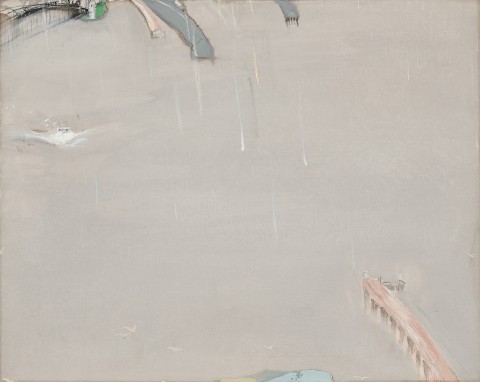HARBOUR IN THE RAIN, 1977
BRETT WHITELEY
oil on canvas
61.0 x 76.5 cm
signed, dated and inscribed with title verso: ‘HARBOUR IN THE RAIN’ / brett whiteley 77 / oil
Australian Galleries, Melbourne, 1993 (stock no. 10315)
Private collection
Savill Galleries, Sydney (label attached verso)
Private collection, Sydney
Sutherland, K., Brett Whiteley: Catalogue Raisonné, Schwartz Publishing, Melbourne, 2020, cat. 125.77, vol. 7, p. 409
Pissing Down All Day, 1977, oil on plywood panel, 45.0 x 85.0 cm, private collection, Melbourne, illus. in Sutherland, K., ibid., cat. 124.77, vol. 3, p. 450
Fishing Boats Nicking In, 1978, oil on canvas, 61.0 x 76.0 cm, private collection, Melbourne
A meditative work exuding lyricism and tranquillity, Harbour in the Rain, 1977 encapsulates superbly the sensuous Lavender Bay scenes for which Whiteley remains so widely acclaimed and admired. Considered the crowning achievement of his career, the series signalled a marked departure from art as a reforming medium – from politics, social consciousness and a Rimbaudian vision of life as a contest between good and evil – towards tableaux strongly inspired by Matisse and his aspirations for ‘... an art of balance, purity and serenity, devoid of troubling or depressing subject matter, an art which could be… a soothing, calming influence on the mind, something like a good armchair in which to relax from physical fatigue.’1
Early in 1974, a large and successful retrospective exhibition of his drawings at Bonython Gallery had enabled Brett and his wife Wendy to purchase the Lavender Bay house they had been renting, thus signifying Whiteley’s emotional bonding with Australia – ‘a centring, as it were, of his universe.’2 As Wendy later recalled, ‘in a sense Lavender Bay was Brett’s return to paradise, having come from a very anxious situation – and it is paradise. He said some quite tender things at the time, like “I’m at home at last”...’3 From this stable domestic base, and quite literally, his living room window, Whiteley now turned to the Harbour for inspiration, with the brilliant ‘optical ecstasy’ of Lavender Bay – burnt orange in the midday sun, sparkling sapphire blue at twilight or drenched pearl-grey in the rain (as featured here).
Seduced by this new muse, this enchanting siren of Sydney Harbour, Whiteley would continue over the next two decades to explore further the theme of Lavender Bay, capturing her many moods through sumptuous interiors, harbour views and still-lifes. The result was indeed his most celebrated body of work for within three years of embarking upon the series, Whiteley had won three of Australia’s most coveted art awards, all with Lavender Bay paintings notably executed in or around the same year as the present painting – the Archibald Prize for Self-Portrait in the Studio, 1976; the Sulman Prize for Interior with Time Past, 1976; and the Wynne Prize for The Jacaranda Tree (On Sydney Harbour), 1977.
A stunning example from this pivotal period within the artist’s oeuvre, Harbour in the Rain poignantly evokes the poetry of the bay with its subdued palette of grey and cream, sensuality of line and intricate sketched detail, including Lavender Bay pier and glimpse of the Harbour Bridge and Opera House beyond. As such, the composition bears strong stylistic affinities with Pissing Down All Day, 1977; Grey Harbour, c.1978, and Fishing Boat Nicking In, 1978. Beyond any formal concerns, however, Whiteley’s abiding preoccupation with such panoramas lay in immortalising the beauty of his subject; as he observed in the introduction to the catalogue accompanying his ground-breaking show at Australian Galleries in 1974, these paintings ‘begin from the premise of recording the glimpse seen at the highest point of affection – points of optical ecstasy, where romanticism and optimism overshadow any form of menace or foreboding.’4
1. Matisse cited in McGrath, S., Brett Whiteley, Bay Books, Sydney, 1992, p. 181
2. Wendy Whiteley cited in Pearce, B., Brett Whiteley: Art and Life, Thames and Hudson, Sydney, 1995, p. 35
3. Ibid., p. 48
4. The artist, quoted in McGrath, op. cit., p. 185
VERONICA ANGELATOS
